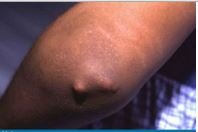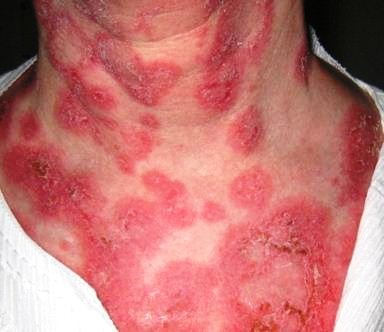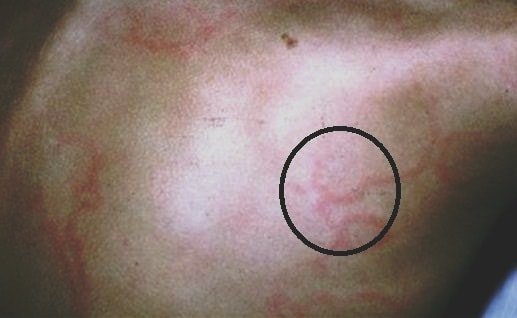Erythema Marginatum
What is Erythema Marginatum?
Erythema marginatum is a red skin rash that can become a serious health issue as it is associated with rheumatoid fever. Erythema marginatum is ring shaped painless firm rash. It develops on the surface of the skin and internally it can extend to the subcutaneous tissues.
The central part of the rash is clear and flat but the borderline part of the rash is elevated. Usually these rashes are situated on the thighs, arms and other parts of the upper / lower limbs of the body. Sometimes it can also develop on the back of the body. Usually the facial region, palms and feet are not affected. Often these rashes go uncared for from a doctor because they are painless. [1, 4, 5]

Image 1 : Erythema Marginatum
Definition
In medical science, erythema stands for redness of the skin and the Latin word “marginatum” means margin. Clinically erythema marginatum is a disease which is characterized by red skin rashes which look like nodules with distinct margins. The edge of the rash is inflamed. There are two types of erythema marginatum.

Image 2: Cutaneous nodules in Erythema marginatum
- Erythema marginatum rheumaticum is related to rheumatic fever and progresses on the thighs and on other parts of the limbs. In the initial stage, it is difficult to diagnose as it does not show associated symptoms. In this type of erythema it is superficial.
- Erythema marginatum perstans does not develop only on the skin surface but it also affects the underlying tissues of the skin. These rashes can develop in any part of the body except the palms and feet. This type is thought to be associated with other underlying causes. [1, 4, 5]
Causes
Erythema marginatum occurs due to the development of other associated diseases. Sometimes the underlying cause is unpredictable and unclear. One of the most related causes is rheumatic fever. Erythema is usually seen in children but it can occur in adults too.
Rheumatoid fever arises due to bacterial infection caused by streptococcal A bacteria. This bacterial attacks the immune system and causes autoimmunity issues. Development of erythema marginatum does not always cause rheumatic fever but it is associated with Jones’ criteria and it can give confirmation of rheumatic fever. Temperature increases cause rash development throughout the body except on the face, palms and soles. After onset of fever, the rash arises within two to three weeks. Initially the rash develops on the thighs and gradually extends toward upper directions.
C1-INH deficiency also causes erythema marginatum. Deficiency of C1-INH causes sudden fluid accumulation which results in inflammation. This condition is also associated with skin diseases, itching and platelet deficiency.
The rashes appear and disappear on their own. It is unpredictable how long they take to appear on the surface of the skin. They may stay for weeks, months or years. In some cases, they naturally go away and reappear again after a few weeks or months.
Other causes behind erythema marginatum are:
- Cancers like blood cancer, lymphoma, squamous cell carcinoma and breast cancer
- Infection caused by borrelia burgdorferi which results in Lyme disease
- Allergic reactions
- Bacterial and fungal infections which include Escherichia Coli, Ascaris Lumbricoides and Candida Albicans
- Puberty and pregnancy
- Adverse drug effects (antibiotics like penicillin, H2 anti-blockers like Cimetidine, anti-malarials like Chloroquine, Hydrocychloroquine) [1, 2, 5]
Symptoms
Red rashes are the prime symptom of erythema marginatum. The significant characteristics of the rash are:
- The shape of the rash is quite similar with doughnuts, the centre of the rash is pale in comparison with the edges which are red in color
- Inflamed margins which develop due to swelling of the blood vessels which lead to the gathering of WBC’s
- The diameter range of the circular rashes are in between 0.5 – 2 cm
- The initial occurrence of the rash is on the thighs and gradually extends in an upward direction but it never develops on the palms, feet or face
- No itching is associated with the rash, high temperature aggravates the symptoms by darkening the red color of the rashes [1, 4, 5]
Treatment
Erythema marginatum needs a symptomatic approach for the underlying cause. For effective treatment of erythema marginatum, it is always crucial to diagnose the underlying cause. Erythema marginatum does not usually need any therapeutic approach because it naturally goes away whenever the underlying cause is eliminated or cured.
Development of erythema marginatum does not produce any pain or irritation. Usually the patient does not even notice a problem. Erythema marginatum is linked with rheumatoid fever which can become a serious health problem as it may turn into rheumatoid heart disease or Sydenham’s chorea. Early treatment is essential for restricting these complications.
Other associated conditions like allergies or infections can be treated with anti- allergic drugs or anti-bacterial / anti-fungal drugs. The avoidance of materials which produce the allergy also improves the condition.
If erythema marginatum arises due to an adverse drug reaction, then consult with a doctor because stopping the drug can improve the condition. [1, 5]
Erythema marginatum Pictures




Reference List:
- Bye Bye Doctor, Available at: http://byebyedoctor.com/erythema-marginatum/
- Derm Net, Available at: https://www.dermnetnz.org/topics/rheumatic-fever
- DX Path, Available at: http://www.dxpath.com/histlib/erythema-marginatum-histopathology-20831.html
- Patient Info, Available at: http://patient.info/doctor/erythema-marginatum-rheumatica
- Right Diagnosis, Available at: http://www.rightdiagnosis.com/e/erythema_marginatum/intro.htm
